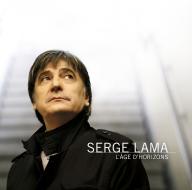Born Serge Chauvier in 1943, Lama was raised in a musical atmosphere, his father having been a lyrical singer. Seing him give up his career to put enough food on the table has been a marking experience for Serge, swearing since then he'd succeed where his father hadn't. Writing a lot, Lama quickly tried to find dates and places to perform and was quite soon spotted by Barbara herself, who obtained regular shows for him in her usual Parisian cabaret, L'Écluse. This was a major step in Lama's career, and he began recording as soon as 1964, releasing a debut four-song EP. Things only got better when he was offered to open for Georges Brassens, alongside Barbara, in Bobino that same year. A new single, Les Ballons Rouges, came out in 1965. But tragically, this lightning-fast ascension was stopped by a car accident, costing Lama the loss of his girlfriend and leaving him crippled, having lost the use of almost all of his body. The way he came back to activity in the following months, with the help of Georges Brassens, certainly added to his aura.
He went back to recording as soon as 1967, and since then, and through the '70s, built up a writing team composed of Yves Gilbert and Alice Dona for compositions and Jean-Claude Petit for arrangements, singing a batch of popular singles, among them Je Suis Malade and Les Petites Femmes de Pigalle. His songs subjects earned him a few attacks, some people accusing him of male chauvinism, particularly on tracks like Femmes, Femmes, Femmes and Superman, but those attacks couldn't stop Lama's increasing popularity, his concerts attracting more and more audience. He took some time in the early '80s to write a musical based on the historical character Napoléon Bonaparte (an intriguing figure to Lama) simply entitled +Napoléon. The show encountered massive popularity and critical praise, crossing France's borders and spreading to Belgium, Switzerland, and even Quebec. That was the beginning of a new career for Lama, who left the music business after +Napoléon to concentrate on acting.
He finally came back to singing in 1994 with the eponymous album Lama, and began to record and tour again through the '90s and 2000s, with a much weakened aura, but with a still faithful fan base. Lama was his only studio album of the '90s, though he also released a live album in 1998, recorded at the legendary Olympia in Paris with a symphony orchestra. He continued to focus on acting in the 2000s, although a trio of moderately successful albums kept him in the music-buying public's consciousness: Feuille à Feuille (2001), PluriElles (2003) -- a disc of duets with popular female artistes -- and L'Âge d'Horizons (2008). Hip surgery slowed him down briefly, before he bounced back in 2012 with La Balade du Poète, a double CD featuring re-recordings of some of his best-known hits, and toured again in 2013 to celebrate both his 70th birthday and a staggering 50 years in the business. ~ Olivier Duboc, Rovi


















